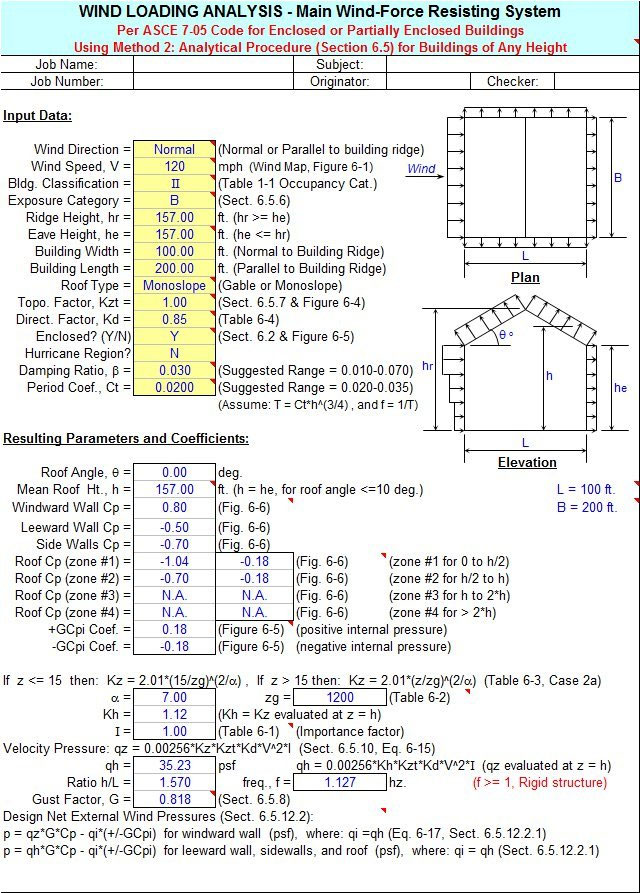
Download excel based program for wind load calculation
Tweet
Wind load of structure means the ?load? established by the wind speed and its air density onto a building.
High velocity winds contribute to generate low pressure areas on the building which develops suction pressure. Some are so powerful that they can extract the corner of a home?s roof.
There are following 3 components in a wind load: Uplift Load, Shear Load, Lateral Load
This exclusive excel based program adheres to ASCE705W ASCE 7-05 and specifically designed for making analysis of air load for code and structures. This spreadsheet facilitates to measure the air pressure with coefficients & compatible parameters as well as net design estimates or computation of air pressure.
Wind Load Calculator - This workbook based program comprises of the following nine (9) worksheets :-
a. Simplified ? Analysis with hassle free process for upgrading home with <= 60?
b. MWFRS (low-rise) ? Prime air-power resistance system for low-end house <= 60 ?
c. MWFRS (any HT) ? The prime wind power protection system for the building with different heights.
d. Wall C and C wall components and cladding analysis
e. Roof C and C ? Roof material and cladding analysis
f. Stack and Tank ? Condensed Chimney, Stack and Vertical Tank Analysis
g. Open framework (no roof) ? Analyze the open framework exclusive of ceiling
h. Wind Maps ? Basic Wind Speed Maps (Figure 6-1 for code ASCE 7-05)
Program ideas and limitations:
1. With the use of ?ASCE 7-02 Air Load Regulation Usage Guidelines?, this program finds out the external air pressure group employed in outdoor air pressure assistants, ?GCP?, Wall C and C and Roof C and C worksheets.
2. Workshops for ?MWFRS (any HT)?, ?Wall C and C?, and ?Roof C and C? are suitable for home with an average ceiling height of up to 500 feet.
3. For ?simplified? analysis, it is suited for low-growth house as it fulfills the criteria of Section 6.4.1.
4. In the worksheet for simplified analysis, the design is computed for each side of the MWFRS air load. MDFRS design should have been loaded in total length of the building length.
5. Worksheet for ?MWFRS (Low-Rise)? will be effective for low-rise home defined in section 6.2.
6. The ?open structures? worksheet is suitable for open frames devoid of a 500 ft tall roof. It is utilized for open-process-type structure and pipe / utility racks and bridges.
7. User defined steps are applied to specify air pressure distribution in the worksheet for ?Z?, ?MWFRS (any HT)?, ?Wall C and C?, and ?Roof C and C?.
8. ?May MWFRS (no HT)?, ?Stack and Tank? and ?Open Structures? worksheets can deal wth ?strict? and ?flexible? buildings and structures. For ?strict? buildings or structures, this program applies a counting value of 0.85 or a glass effect factor, ?g? code code code 6.5.8.1. For ?flexible? buildings or structures, it calculates the ?gf? in accordance with the vibration section 12.8.2.1, code as part of the approximate time of code 6.5.8.2, where the formula X ?X? = City * H ^ X 0.75 is taken into consideration.
9. Workshops for ?Wall C and C? and ?Roof C and C? for flat roof buildings, Galilei roof buildings containing oof corners <= 45 degrees and ceiling corners containing monosclosure roof buildings <= 3 degrees.
10. ?Stack and Tank? worksheet is suited for the 600 feet long arch welded structure.
11. This program contains various ?comment boxes? where several information along with input or output items are available, utilization of equations, data tables, etc. (Note: The display of the ?Comment Box? is denoted with the ?red triangle? in the top right corner of a cell, in particular the purpose of the mouse pointer is to transfer the contents of the ?comment box? to the desired room.)
Click on the following link to download the sheet civilengineeringbible.com

